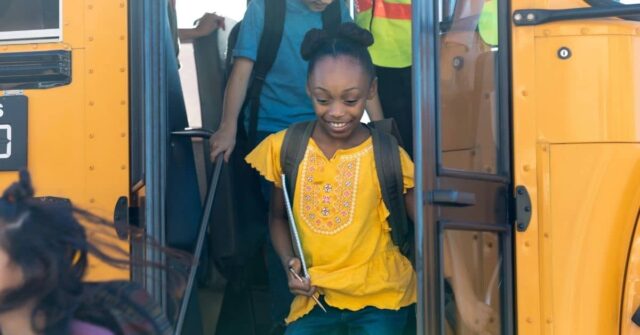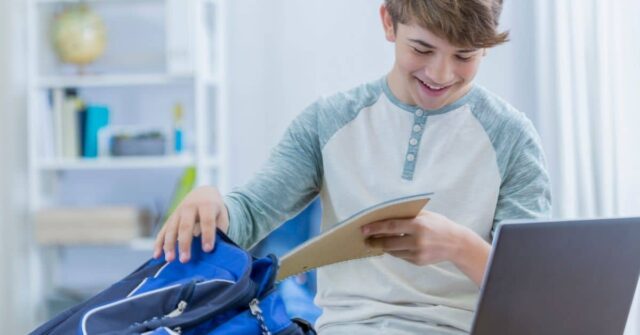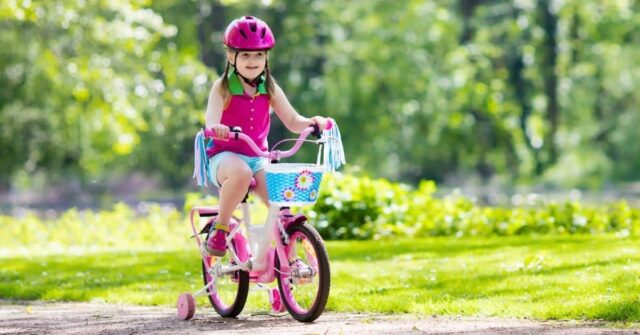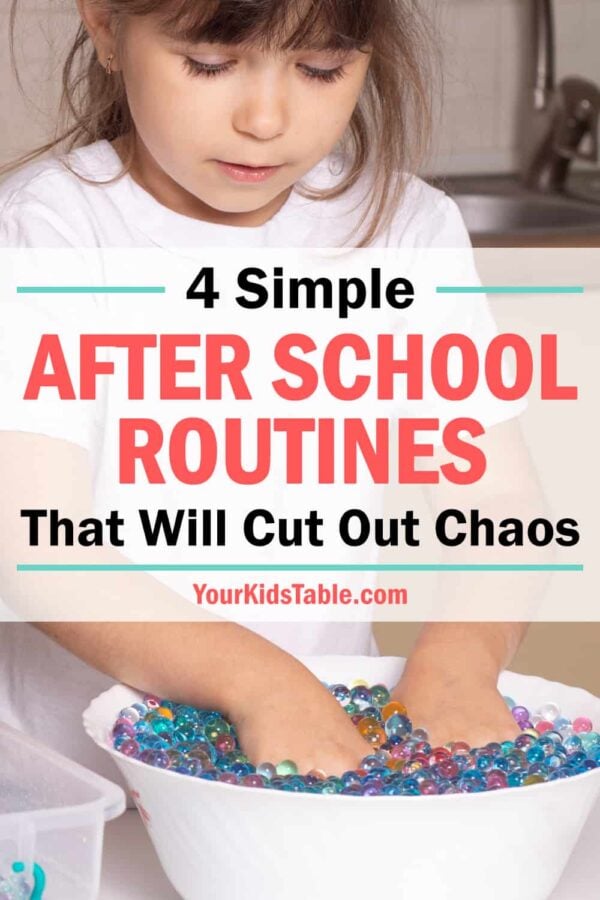After school routines can help kids calm and transition back to being at home after a long school day. Check out these 4 simple after school routines for kids of all ages.
She walked in the door after a 7 hour school day and already seemed edgy.
When her mom asked her how her day was, she said “Terrible.” Unfortunately, this response wasn’t any cause for alarm because Kayla often reported the school day was awful, bad, or terrible. Despite her mom trying to be positive, that was only the beginning of a downward spiral of Kayla’s behavior for the rest of the day.
Soon after she came in, she started a fight with her little brother, screamed at her mom, and stomped upstairs to her bedroom. She snapped at everyone for the next couple of hours, only calming down after she played outside with a friend and had some dinner.
By then, Kayla’s family was worn down and emotionally exhausted. Kayla then revealed she had 3 long pages of homework she had to get done before school tomorrow, on top of showering and getting her lunch packed.
With only an hour and half left to fit all that in, a battle began to ensue. Kayla missed her shower and dad had to walk her through every step of her homework, half completing it himself.
Everyone went to bed frustrated, hoping that somehow tomorrow would be different.
Sound familiar?
This is just one example of how kids can have a hard time transitioning from school back to home, or that they simply struggle to manage their time well.
Why Some Kids REALLY Need an After School Routine
Some kids are hyper and jumping off the wall when they get home from school. Others are soooo lethargic they don’t want to do anything. And, some are like Kayla, irritable.
In all of these situations, and many more, a simple age-appropriate after school routine could drastically help kids have an enjoyable evening.
Or, at a minimum, save your sanity so you aren’t running around putting their bookbag away and arguing over when their homework will get done.
Why does an after school routine help?
In school, kids are in a highly structured environment, often they need to “keep it together” all day, this is especially true if they have sensory processing difficulties or other special needs. They’re working hard to follow directions, pay attention the best they can, and socialize with peers.
There are a lot of demands on them, and in most schools, kids don’t get to MOVE as much as they need to.
As a result, they can become really dysregulated. And, when kids get dysregulated, they feel out of sorts and will over-react or totally shut down.
The after school routine is there to help them regulate and know what to expect. It might be too big of a gap for some kids to go from total structure to none. The after school routine serves as a transition and can potentially teach your child some responsibility as they take care of their own school items and self care.

Do All Kids Need an Afterschool Routine?
Not all kids necessarily need an after school routine, or they may need a very loose one. An after school routine can be as simple as washing hands, unpacking their book bag, and putting that bookbag away.
Think of your child’s needs, are you or your child frustrated after school? Is there any stress? If so, then an afterschool routine is definitely worth trying for a few weeks.
If not, then it’s probably not necessary.
Carefully Consider What Your Including in Your After School Routine
Below you’re going to find a variety of after school routines for kids of all ages, but it’s important to consider which elements of the routine you should and should not include in your home.
Some kids will need more elements in their routine, others will need less.
Several kids will need an after school snack because they ate lunch at 10:30 in the morning (as is the case with my youngest son this year), and others will not need a snack because they had one before leaving school.
Other kids will have a lunchbox that you’d like them to unpack, and some may buy their lunch at school or you don’t mind cleaning it out.
Some kids will need down time, while other kids will need to run, jump, or ride a bike. It’s important to think about what your child’s needs are. If you aren’t sure, you can ask them for some input or do some experiments until you find a consistent routine.
Is Screen Time Okay to Include as Part of the After School Routine?
Screen time is hot topic, and if you follow along here, you know I believe in keeping it to a minimum as much as possible for our kids. Read more about how to decrease screen time for kids here.
But the truth is, some kids really benefit from having some screen time when they get home from school.
A good friend of mine’s son has Autism, he does well at school, but it’s a lot for him. He really enjoys screen time and it’s a chance for him to shut everything out for a little bit. After they’ve had snack and gone through his bookbag, he has a half an hour of screen time as part of his after school routine.
It works for them.
In my house, I’ve noticed my kids feel more grounded when they go outside or do a physical activity, so screen time isn’t part of our after school routine. Think about what would be a good fit for your child and if you want to include screen time, you can add it to any of the sample routines below.

Simple After School Routine for Preschoolers to High Schoolers
As children age, their responsibilities and expectations will undoubtedly change. However, every child is different, and if your child has unique needs you need to consider then adapt and make your own routine. In fact, I encourage it.
You may find your routine even changes throughout the school year or as the seasons change.
First, I’m going to make a huge list of all the different types of things you may want to include as part of your after school routine, and then, you’ll find some specific examples by age.
Possible Steps to Include in Your After School Routine:
- Ride bike/run/skip/gallop home from school or bus stop
- Chew gum or suck on lozenge on way home from school or bus stop
- Change clothes/out of uniform
- Eat a snack
- Have a cold/hot drink or smoothie
- Unpack bookbag/lunch box/coat and put it away
- Do homework
- Quiet time in bedroom or private space
- Play in a sensory bin or sandbox
- Wash hands
- Read a book or magazine
- Ride in or on a swing (see different types of swings here)
- Unload the dishwasher/put away dishes
- Straighten up their bedroom
- Run around outside or play a physical game inside
- Jump on a trampoline, couch, or bed
Sample After School Routine for a Preschooler:
- Unpack bookbag and put it away
- Wash hands
- Look at papers sent home together
- Eat lunch/have a snack
- Run around outside/have a dance party/jump on trampoline
- Independent play with a toy or activity of your child’s choice
Sample After School Routine for Kindergarten through 4th grade:
- Wash hands
- Ride bike home from the bus stop or school
- Eat a snack together
- Talk about their day at school
- Unpack bookbag and lunch, put it away
- Straighten up bedroom
- Have quiet time in bedroom for 20 minutes
Sample After School Routine for Middle Schoolers (5th through 8th grade):
- Unpack bookbag and give any necessary papers to parents or put them in a predesignated area where parents can find them
- Wash hands
- Eat a snack
- Unload dishwasher
- Exercise, run, jump on trampoline
- Do homework
Sample After School Routine for High Schoolers:
- Wash hands
- Eat a snack
- 20-30 minutes of free time, encourage some quiet time or exercise
- Do homework
- Help with dinner prep or put dishes away
Talking to Your Child About Their After School Routine
You know your child best. Your child may respond better to the routine if you don’t make a big deal about it and just tell them each step for the first couple of days or weeks until they fall into a routine.
Or, your child may benefit from you explaining that you’re going to have an after school routine and letting them know what it is. Some kids will do even better if they have a checklist of the steps in your routine so they can easily follow it. A picture of each step is helpful for kids that can’t read. You can hang it right on the fridge.
If you ride or walk your child home from school, it may be helpful to remind them of the steps they’re going to do when they get home.
Take a few minutes to think about if, and how much, you should talk to your child about their after school routine.

Troubleshooting Your After School Routine!
Before you even try out an after school routine, expect it to take time, especially if your child isn’t used to following one. We don’t want them to have a negative association with the routine, so give them some grace as they get used to it.
It may take a few weeks, or in some cases a few months, before everyone is rolling with the routine.
One of the biggest pitfalls for parents is giving up on the routine too soon because your child is resisting it. If they don’t want to follow what you’re asking them to do, then make it simpler. Take one step at a time.
Ask them why it’s hard, maybe they feel it’s too demanding right after school and are truly overwhelmed. You’d want to know that so that you can adjust the routine, especially when it comes to homework.
While homework is included in many of the sample after school routines, some kids will struggle to jump right back into school work when they get home. Your child may do better with doing their homework after dinner or an hour after they get home and they’ve had some free time.
If your child consistently has homework, establish when it will get done, even if it’s on a day-by-day basis. And remember, homework can be done laying on the floor or while sitting on a yoga ball.
When you offer a fun or different location to do homework instead of at a desk or table, some kids will focus better.
As an occupational therapist, the most important element of the after school routine is that your child has a chance to move, get some quiet time, or both, so they can regulate their bodies and emotions. If you have to choose one thing to focus on, start there! Look for tips for transitioning back to school after an extended break here!
Do you have some ideas for your child’s after school routine? Have any questions about your situation? Ask us in the comments below, we respond to every single one!
Grab Our Free Sensory Activity Printable
Sensory activities are an incredible way to calm and ground kids, especially after school. We’ll send you our 25 Powerful Sensory Activities to Calm and Focus Your Child right to your inbox when you click the link below. It’s packed with genius ideas you can use TODAY!
Click here to get the free printable!
More Help for Kids in School
The Best Fidget Toys for School that Help with Wiggles and Attention
5 Fine Motor Activities to Get Kids Ready for School
Easy Movement Break Ideas Kids Can Do at Home or School
7 Tips to Get Picky Eaters Eating the School Lunch
Alisha Grogan is a licensed occupational therapist and founder of Your Kid’s Table. She has over 17 years experience with expertise in sensory processing and feeding development in babies, toddlers, and children. Alisha also has 3 boys of her own at home. Learn more about her here.

I loved these tips! Establishing a routine has made such a difference in our afternoons. My kids are actually helping with their own tasks now, and it’s reduced the chaos significantly. Thanks for the practical advice!
This is so helpful! As a new kindergarten mom, I’ve been trying to navigate the after school routine in order to prevent meltdowns. A snack and outside play is super important for my social little one to feel regulated and for the rest of us to have a pleasant evening. This is definitely adaptable to all caregiver situations, even kids that come home by themselves!
Hey Laura,
We’re so glad that you found it helpful! And yes, this can definitely be adapted for so many different situations! Kindergarten can be an especially challenging time for meltdowns because the newness of school can be extra overwhelming! We hope some of these activities make a little bit of a difference for you guys 🙂
Best,
Andrea
Thanks! The idea of an after school routine never crossed my mind for my K and Pre-K boys but we have the same struggles as you described when I pick them up at 5. We will be trying the hand wash (because eww germs) and un-packing the backpack routine, followed by quiet time play for my sensory K one and physical activity for my Pre-K one. We’ve found screen time to be too stimulating for both and struggle with adding a snack vs bidding time until I can manage some sort of dinner they will actually eat by 5:30.
Hey Jules,
That sounds like a perfect plan, we’re so glad you found it helpful! And yes the handwashing definitely helps get rid of all those germs they bring home! Let us know how it goes 🙂
Best,
Andrea
This is the most upsetting and privileged set of after school recommendations I’ve ever seen, and takes no account of families where the adults actually have jobs.
How so? My husband and I work full-time, and our son gets home from daycare with one of us around 5:30pm. I could see us following the preschooler routine.
Yes, I’d like to know how this suggestion is upsetting as well.
In my own experience when my son was little (and I was working and going to university) having a basic routine worked well for him. It was simplified. Wash hands & eat a snack, down time for 30min – play/read/watch a show/draw, help make dinner, work on homework. This was the routine whether he was with me or at the sitter’s house. Then when we got home the before bed routine was some version of – pick out season appropriate clothes for tomorrow, wash hands&face OR take shower, brush teeth.
When he was with someone else, I’d have him pack his snack specifically for the after school snack. This could be as simple as a pb&j or trailmix. We’d talk about how one snack was the school snack and the other was the after school snack. If his sitter was picking him up after school sometimes the ‘wash hands’ part was a babywipe. The elements were flexible, but he definitely got used to the -hands -snack -downtime -dinner – homework. It was easy to remember and worked well to make the time between after school and 7 or 8pm to smoother for him wherever he was. I don’t think that helping him know what to do with a routine was “privileged ,” I was just exhausted and so was he and we needed to find something that worked for that transition for all of us.
Hey Emily!
That wasn’t our intention at all. We know working full time with kids can be a challenge for sure! We’ve definitely been there and experienced the chaos that can sometimes happen with coming home late with tired kids and having to get dinner on the table and homework done. Many of these activities can still work well when that is going on. You can set your child up with a quick activity of their choice while you make dinner or turn on some music and have a dance party together before you start glancing over homework. Even a small 5 minute activity to unwind and connect and make a difference.
Best,
Andrea